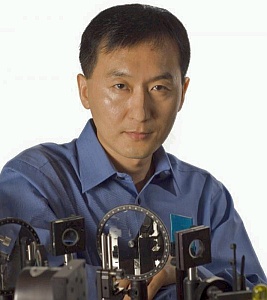 Scientist Chunlei Guo discovered a way to change the surface of a variety of metals so they absorbed virtually all light by using intense laser light in late 2006. He followed up his “black metal” discovery in 2008 by discovering how to use the same basic process to alter surface properties to turn metals a variety of colors. Now Guo and his University of Rochester colleagues have discovered that the altered black metals can detect electromagnetic radiation with frequencies in the terahertz range, also known as T-rays, which have potential in medical and scientific scanning applications, as well as security scanners.
Scientist Chunlei Guo discovered a way to change the surface of a variety of metals so they absorbed virtually all light by using intense laser light in late 2006. He followed up his “black metal” discovery in 2008 by discovering how to use the same basic process to alter surface properties to turn metals a variety of colors. Now Guo and his University of Rochester colleagues have discovered that the altered black metals can detect electromagnetic radiation with frequencies in the terahertz range, also known as T-rays, which have potential in medical and scientific scanning applications, as well as security scanners.
With wavelengths shorter than microwaves, but longer than infrared rays, T-rays occupy a place in the electromagnetic spectrum that is capable of exciting rotational and vibrational states of organic compounds, like pathogens. This quality could allow doctors and biomedical researchers to get previously impossible glimpses of diseases on the molecular level. In addition, unlike X-rays, T-rays are non-ionizing, which means that people who are exposed to them don’t risk the possible tissue damage that can result from X-rays.
To create the T-ray absorbing black metal Guo exposes the metal to a beam of ultra-brief, ultra-intense laser pulses called femtosecond laser pulses. The laser burst lasts less than a quadrillionth of a second. To get a grasp of that kind of speed, consider that a femtosecond is to a second what a second is to about 32 million years.
During its brief burst, Guo’s laser unleashes as much power as the entire grid of North America onto a spot the size of a needle point. Despite this, the femtosecond laser can be powered by a regular wall socket. That intense blast forces the surface of the metal to undergo some dramatic changes creating nanostructures that makes them extremely efficient in absorbing terahertz radiation.
University of California, Berkeley, bioengineering Professor Thomas Budinger says terahertz radiation is like much-higher-frequency radar, except that it theoretically can allow its users to see intricate details of tissue architecture, on the scale of one-thousandth of a millimeter and smaller, instead of large objects like airplanes and boats.
“Terahertz electromagnetic radiation has the capability to interrogate tissues at the cellular level. If applied within microns of the subject of interest, this form of imaging has the theoretical capability to detect properties of molecular assemblages that could be attributes of disease states,” Budinger said.
Although the potential of T-rays in the areas of medical imaging, security scanning and scientific imaging has been known for some time, they have remained notoriously difficult to detect because typical materials do not readily absorb that frequency. However, after undergoing Guo’s technique, metals become over 30 times more absorptive.
“When we turned metals black, we knew that they became highly absorptive in the visible wavelength range because the altered metals appear pitch black to the eye. Here, we experimentally demonstrated that the enhanced absorption extends well into the far infrared and terahertz frequencies,” Guo said.
As promising as T-rays sound, there are still some questions to be answered regarding their safety. Although terahertz photons are not energetic enough to break chemical bonds or ionize atoms or molecules, which are the main reasons X-rays and UV rays are so damaging, they may damage us in other ways.
Recent research by Boian Alexandrov and colleagues at the Center for Nonlinear Studies at Los Alamos National Laboratory in New Mexico examining how terahertz fields interact with double-stranded DNA has indicated they could significantly interfere with processes such as gene expression and DNA replication. Alexandrov says that although the forces generated are tiny, resonant effects allow terahertz waves to “unzip” double-stranded DNA, creating bubbles in the double strand.
T-rays are naturally present in our environment, just like UV and infrared light, but if our exposure to them is set to dramatically increase through emerging technologies, such as Guo’s black metal, then it might be worth figuring out just how much exposure is too much before T-rays become widely used in hospitals and airports
Source Gizmag https://www.gizmag.com/t-rays-detected-black-metal/13555/
